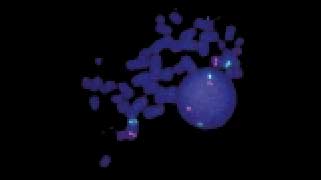The Vysis EGR1 FISH Probe Kit – SC (Specimen Characterization) detects the LSI EGR1 probe target on chromosome 5q in bone marrow specimens. The Vysis EGR1 FISH Probe Kit – SC assay results characterize bone marrow specimens from patients with acute myeloid leukemia or myelodysplastic syndrome. The assay results are intended to be interpreted by a qualified pathologist or cytogeneticist. This device is not intended for high-risk uses such as selecting therapy, predicting therapeutic response or disease screening. The use of this product for diagnosis, monitoring or risk assessment has not been established.
Vysis EGR1 FISH Probe Kit – SC Contents
This kit contains 5 reagents sufficient to process 20 assays.
An assay is defined as one 22 mm x 22 mm LSI EGR1/D5S23, D5S721 DNA probe hybridization area.
Each kit includes:
- Vysis LSI EGR1 SpectrumOrange/D5S23, D5S721 SpectrumGreen Probes
- 1 vial, 20 μl per vial (100 and 300 ng/μL)
- Vysis LSI/WCP Hybridization Buffer
- DAPI II Counterstain
- 1 vial, 600 μL per vial (125 ng/mL)
- NP-40
- 2 vials, 2000 μl per vial
- 20x Standard Sodium Citrate (SSC) Salt
Indications and Limitations of Use
Intended Use
The Vysis EGR1 FISH Probe Kit – SC (Specimen Characterization) detects the LSI EGR1 probe target on chromosome 5q in bone marrow specimens. The Vysis EGR1 FISH Probe Kit – SC assay results characterize bone marrow specimens from patients with acute myeloid leukemia or myelodysplastic syndrome. The assay results are intended to be interpreted by a qualified pathologist or cytogeneticist.
This device is not intended for high-risk uses such as selecting therapy, predicting therapeutic response or disease screening. The use of this product for diagnosis, monitoring or risk assessment has not been established.
Limitations of the Procedure
- FOR IN VITRO DIAGNOSTIC USE ONLY.
- The Vysis EGR1 FISH Probe Kit - SC is intended to be used in combination with additional biomarkers, morphology, and other clinical information.
- If a specimen has an overall low signal intensity FISH pattern and a low level of cells with an atypical (1R2G) FISH signal pattern, use of the appropriate single-pass filter to confirm the pattern is recommended. Failure to follow this recommendation may result in inaccurate identification of signals.
- Other abnormal signal patterns may occur, and metaphase analysis may be helpful in characterization of such patterns.
CAUTION: United States Federal law restricts this device to sale and distribution to or on the order of a physician or to a clinical laboratory; use is restricted to, by, or on the order of a physician.


.png)
